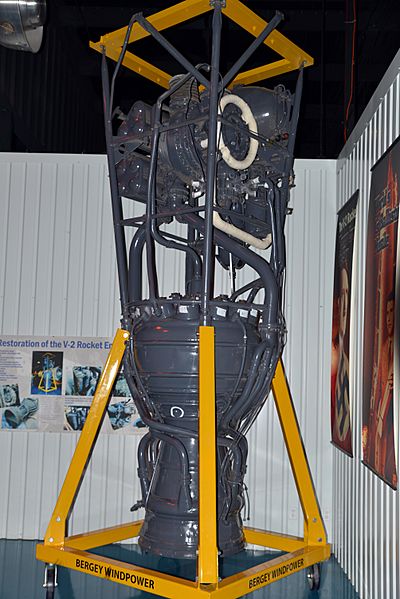Image: Stafford Air & Space Museum, Weatherford, OK, US (42)

Description: The restored engine of a German V-2 rocket from World War Two. The V-2, the world's first ballistic missile, carried a 2,200 lb (1,000 kg) conventional-explosive warhead, had a range of 200 mi (320 km), and weighed 28,000 lb (13,000 kg) at launch. It was a liquid-propellant rocket, with the oxidizer being liquid oxygen and the fuel being a mixture of 75% ethanol and 25% water. (The water kept engine temperatures down.) The tanks for these propellants were stacked on top of the engine. The engine produced about 56,000 lbf (25,000 kgf; 250 kN) of thrust and burned for about 65 seconds. It was fed by a pair of centrifugal turbopumps (one for fuel and one for oxygen) driven by a 580 hp (430 kW) steam turbine; steam for the turbine was generated by combining high-test hydrogen peroxide with a sodium permanganate catalyst to decompose the peroxide into superheated steam and oxygen. At the top of the engine are the propellant turbopumps and the associated plumbing for generating steam; the oxygen turbopump is on the right, closest to the viewer, and to its left are the steam turbine and the (mostly hidden) fuel turbopump. To the rear, behind the oxygen turbopump, is the tank for the hydrogen peroxide. At the bottom of the turbopumps are connections for oxygen lines which run to the combustion chamber and for fuel lines running to the thrust nozzle. The combustion chamber, above the nozzle, has 18 small cup-like burners projecting from its top surface. These burners were based on a smaller combustion chamber design, producing around 3,300 lbf (1,500 kgf) of thrust, which was the largest that German scientists could get working when the V-2 missile was ordered into production. Each burner was fed with its own oxygen line, leading to a confusing tangle of lines, most of which are not installed in this restored engine. The burners all opened into the main combustion chamber, which opened into the nozzle. To keep the combustion chamber and nozzle from overheating and "burning through", the fuel was fed into the nozzle's double walls at the bottom and flowed upward to the burners. The thrust frame, mounted to the top of the combustion chamber and extending upward to the top of the engine, transferred the engine's thrust to the rocket structure. (The yellow dolly is only a display mount.) Displayed at the Stafford Air & Space Museum, Weatherford, Oklahoma, U.S.
Title: Stafford Air & Space Museum, Weatherford, OK, US (42)
Credit: Own work
Author: Bubba73
Usage Terms: Creative Commons Attribution-Share Alike 3.0
License: CC BY-SA 3.0
License Link: https://creativecommons.org/licenses/by-sa/3.0
Attribution Required?: Yes
Image usage
The following page links to this image:

